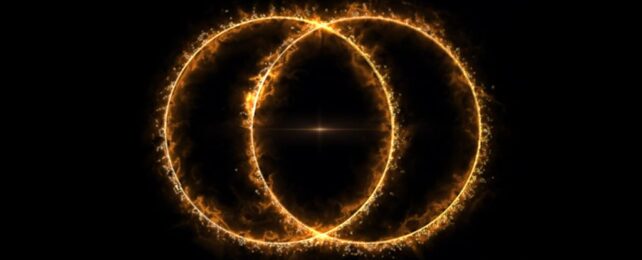Astronomers have discovered a stunning dual-ring system deep in the cosmos – the most powerful and most distant odd radio circle (ORC) to date. It may shed literal light on the processes that can forge these mysterious structures.
In light that has traveled for 7.7 billion years to reach us, a collaboration between citizen scientists and professional astronomers has identified an ORC, named J131346.9+500320, consisting of not one, but two intersecting rings of bright radio light – the strongest ever seen in one of these objects.
Each ring spans roughly 978,000 light-years across, wrapped in a faint halo around 2.6 million light-years wide.
Related: Mysteriously Perfect Sphere Spotted in Space by Astronomers
The source of this double structure, which is a rarity among the already few number of ORCs discovered to date, seems to be powerful winds, or giant shocks, blowing from the supermassive black hole at the center of the galaxy between them, says a team led by astronomer Ananda Hota of the University of Mumbai, and founder of the RAD@home citizen science project.

"This work shows how professional astronomers and citizen scientists together can push the boundaries of scientific discovery," Hota says. "ORCs are among the most bizarre and beautiful cosmic structures we've ever seen – and they may hold vital clues about how galaxies and black holes co-evolve, hand-in-hand."
ORCs, as the name suggests, are peculiar, roughly circle-shaped sources of radio (and only radio) emission that are spotted deep throughout intergalactic space. It's not entirely clear what causes them, but a growing body of evidence suggests that the culprits are space's biggest troublemakers: supermassive black holes.
Throughout the Universe, these cosmic enfants terribles are responsible for all sorts of huge radio structures, from giant lobes to even more giant astrophysical jets. It's not unreasonable to pin ORCs on supermassive black holes, too, especially when so many ORCs appear to be associated with galaxies, all of which host a supermassive black hole in the center.
Supermassive black holes get up to some extreme antics. When they feed, their activity can result in huge jets of plasma punching out into space from the black hole's poles. In addition, they can blast out tremendous winds.
There's also evidence to suggest that one growth pathway for supermassive black holes is collisions with other supermassive black holes during galactic mergers, events that are likely to generate pretty massive shockwaves.
To date, only two of the dozen or so known ORCs have two rings. Scientists think this could mean that we're looking straight down the barrel of two outflows blasted in opposite directions from one object, much like the twin jets that blast from active black holes. However, we know what jets look like, and it's not ORCs.
J131346.9+500320 offers some clues that lead to at least one formation mechanism: galactic superwinds. Lobes and jets eventually spread, fade, and dissipate over time.

"A large-scale shock induced by a galaxy-galaxy or black-hole merger, or a powerful superwind, could compress a dormant radio lobe and reaccelerate its particles to be visible as rings or broken shells," the researchers write in their paper.
However, if a bipolar black hole superwind kicks up after the radio lobes have already reached the relic phase, then the resulting structure could be a twin radio ring that grows to significant sizes, as seen in J131346.9+500320.
The light from this object also suggests that it's generated by old, fading synchrotron radiation. Whatever made it happened long ago – and the ORC we see today is an old, fossil relic of past black hole activity, its glow revived by fresh, powerful winds or shocks.
The researchers describe two other objects in the same paper: RAD J122622.6+640622, a radio galaxy with a bent jet that has a large radio circle at the end; and RAD J142004.0+621715, a radio galaxy with a similar radio circle at the end of a jet. Taken together, the three objects strongly implicate black holes in the creation of ORCs.
"These discoveries show that ORCs and radio rings are not isolated curiosities – they are part of a broader family of exotic plasma structures shaped by black hole jets, winds, and their environments," says astrophysicist Pratik Dabhade of the National Centre for Nuclear Research in Poland.
"The fact that citizen scientists uncovered them highlights the continued importance of human pattern recognition, even in the age of machine learning."
The research has been published in the Monthly Notices of the Royal Astronomical Society.
